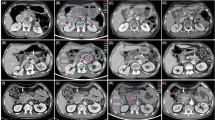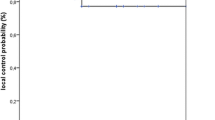Abstract
Purpose
The aim of this work was to evaluate the clinical efficacy and safety of simultaneous integrated boost-intensity modulated radiation therapy (SIB-IMRT) in patients with inoperable hepatocellular carcinoma (HCC).
Methods and materials
A total of 53 patients with inoperable HCC underwent SIB-IMRT using two dose-fractionation schemes, depending on the proximity of gastrointestinal structures. The 41 patients in the low dose-fractionation (LD) group, with internal target volume (ITV) < 1 cm from gastrointestinal structures, received total doses of 55 and 44 Gy in 22 fractions to planning target volume 1 (PTV1) and 2 (PTV2), respectively. The 12 patients in the high dose-fractionation (HD) group, with ITV ≥ 1 cm from gastrointestinal structures, received total doses of 66 and 55 Gy in 22 fractions to the PTV1 and PTV2, respectively.
Results
Overall, treatment was well tolerated, with no grade > 3 toxicity. The LD group had larger sized tumors (median: 6 vs. 3.4 cm) and greater frequencies of vascular invasion (80.6 vs. 16.7 %) than patients in the HD group (p < 0.05 each). The median overall survival (OS) was 25.1 mKonzept ist machbar und sicheronths and the actuarial 2-year local progression-free survival (LPFS), relapse-free survival (RFS), and OS rates were 67.3, 14.7, and 54.7 %, respectively. The HD group tended to show better tumor response (100 vs. 62.2 %, p = 0.039) and 2-year LPFS (85.7 vs. 59 %, p = 0.119), RFS (38.1 vs. 7.3 %, p = 0.063), and OS (83.3 vs. 44.3 %, p = 0.037) rates than the LD group. Multivariate analysis showed that tumor response was significantly associated with OS.
Conclusion
SIB-IMRT is feasible and safe for patients with inoperable HCC.
Zusammenfassung
Zielsetzung
Ziel der Arbeit war es, die klinische Wirksamkeit und die Sicherheit der intensitätsmodulierten Radiotherapie mit simultanem integriertem Boost (SIB-IMRT) für Patienten mit einem inoperablen hepatozellulären Karzinom (HCC) zu evaluieren.
Methode und Material
Bei 53 Patienten mit inoperablem HCC wurden zwei unterschiedliche Dosierungskonzepte je nach Lagebeziehung des internen Target-Volumens (ITV) zum gastrointestinalen (GI-)Trakt eingesetzt: Hochdosiskonzept (HD) und Niedrigdosiskonzept (LD). Bei 41 Patienten in der LD-Gruppe mit < 1 cm Abstand des ITV zum GI-Trakt wurden auf PTV1 55 Gy und auf PTV2 44 Gy in 22 Fraktionen appliziert. Bei 12 Patienten in der HD-Gruppe mit ≥ 1 cm Abstand wurden 66 und 55 Gy in 22 Fraktionen auf PTV1 und PTV2 gegeben.
Ergebnisse
Die Behandlung wurde gut vertragen und es wurden keine Toxizitäten > Grad 3 beobachtet. In der LD-Gruppe waren die Tumoren größer und hatten häufiger eine Gefäßinfiltration als in der HD-Gruppe (Median 6,0 vs. 3,4 cm und 80,6 vs. 16,7 %; jeweils p < 0,05). Die mediane Gesamtüberlebenszeit (mOS) betrug 25,1 Monate. Die 2-Jahres-Überlebensraten des lokalen progressionsfreien Überlebens (2J-LPFS), des rezidivfreien Überlebens (2J-RFS) und des 2J-OS lagen bei jeweils 67,3, 214,7 und 54,7 %. Die HD-Gruppe zeigte ein besseres Ansprechen (100 vs. 62,2 %, p = 0,039) und 2J-LPFS (85,7 vs. 59 %, p = n.s.), 2J-RFS 38.1 vs. 7,3 %, p = 0,063) und 2J-OS (83,3 vs. 44,3 %, p = 0,037) im Vergleich zur LD-Gruppe. Die multivariate Analyse zeigte, dass die Ansprechsrate signifikant mit dem OS korrelierte.
Schlussfolgerung
Das vorgestellte SIB-IMRT-Konzept ist machbar und sicher für Patienten mit einem inoperablen HCC.




Similar content being viewed by others
References
Llovet JM, Real MI, Montana X et al (2002) Arterial embolisation or chemoembolisation versus symptomatic treatment in patients with unresectable hepatocellular carcinoma: a randomised controlled trial. The Lancet 359:1734–1739
Higuchi T, Kikuchi M, Okazaki M (1994) Hepatocellular carcinoma after transcatheter hepatic arterial embolization. A histopathologic study of 84 resected cases. Cancer 73:2259–2267
Llovet JM, Ricci S, Mazzaferro V et al (2008) Sorafenib in advanced hepatocellular carcinoma. N Engl J Med 359:378–390
Cheng AL, Kang YK, Chen Z et al (2009) Efficacy and safety of sorafenib in patients in the Asia-Pacific region with advanced hepatocellular carcinoma: a phase III randomised, double-blind, placebo-controlled trial. Lancet Oncol 10:25–34
Seong J, Keum KC, Han KH et al (1999) Combined transcatheter arterial chemoembolization and local radiotherapy of unresectable hepatocellular carcinoma. Int J Radiat Oncol Biol Phys 43:393–397
Kim TH, Kim DY, Park JW et al (2006) Three-dimensional conformal radiotherapy of unresectable hepatocellular carcinoma patients for whom transcatheter arterial chemoembolization was ineffective or unsuitable. Am J Clin Oncol 29:568–575
Cheng JC, Chuang VP, Cheng SH et al (2000) Local radiotherapy with or without transcatheter arterial chemoembolization for patients with unresectable hepatocellular carcinoma. Int J Radiat Oncol Biol Phys 47:435–442
Meng MB, Cui YL, Lu Y et al (2009) Transcatheter arterial chemoembolization in combination with radiotherapy for unresectable hepatocellular carcinoma: a systematic review and meta-analysis. Radiother Oncol 92:184–194
Korean Liver Cancer Study G, National Cancer Center K (2009) Practice guidelines for management of hepatocellular carcinoma 2009. Korean J Hepatol 15:391–423
Ueno S, Tanabe G, Nuruki K et al (2002) Prognostic performance of the new classification of primary liver cancer of Japan (4th edition) for patients with hepatocellular carcinoma: a validation analysis. Hepatol Res 24:395–403
Okusaka T, Okada S, Ueno H et al (2002) Satellite lesions in patients with small hepatocellular carcinoma with reference to clinicopathologic features. Cancer 95:1931–1937
Ikeda K, Seki T, Umehara H et al (2007) Clinicopathologic study of small hepatocellular carcinoma with microscopic satellite nodules to determine the extent of tumor ablation by local therapy. Int J Oncol 31:485–491
Nakazawa T, Kokubu S, Shibuya A et al (2007) Radiofrequency ablation of hepatocellular carcinoma: correlation between local tumor progression after ablation and ablative margin. AJR Am J Roentgenol 188:480–488
Lencioni R, Llovet JM (2010) Modified RECIST (mRECIST) assessment for hepatocellular carcinoma. Semin Liver Dis 30:52–60
Seong J, Lee IJ, Shim SJ et al (2009) A multicenter retrospective cohort study of practice patterns and clinical outcome on radiotherapy for hepatocellular carcinoma in Korea. Liver Int 29:147–152
Hawkins MA, Dawson LA (2006) Radiation therapy for hepatocellular carcinoma: from palliation to cure. Cancer 106:1653–1663
Kim YI, Park HC, Lim do H et al (2012) Changes of the liver volume and the Child–Pugh score after high dose hypofractionated radiotherapy in patients with small hepatocellular carcinoma. Radiat Oncol Journal 30:189–196
Wang PM, Hsu WC, Chung NN et al (2013) Radiotherapy with volumetric modulated arc therapy for hepatocellular carcinoma patients ineligible for surgery or ablative treatments. Strahlenther Onkol 189:301–307
Gong GZ, Yin Y, Xing LG et al (2012) RapidArc combined with the active breathing coordinator provides an effective and accurate approach for the radiotherapy of hepatocellular carcinoma. Strahlenther Onkol 188:262–268
Yoon H, Oh D, Park HC et al (2013) Predictive factors for gastroduodenal toxicity based on endoscopy following radiotherapy in patients with hepatocellular carcinoma. Strahlenther Onkol 189:541–546
Klein J, Dawson LA (2013) Hepatocellular carcinoma radiation therapy: review of evidence and future opportunities. Int J Radiat Oncol Biol Phys 87:22–32
Bujold A, Massey CA, Kim JJ et al (2013) Sequential phase I and II trials of stereotactic body radiotherapy for locally advanced hepatocellular carcinoma. J Clin Oncol 31:1631–1639
Mizumoto M, Tokuuye K, Sugahara S et al (2008) Proton beam therapy for hepatocellular carcinoma adjacent to the porta hepatis. Int J Radiat Oncol Biol Phys 71:462–467
Gierga DP, Chen GT, Kung JH et al (2004) Quantification of respiration-induced abdominal tumor motion and its impact on IMRT dose distributions. Int J Radiat Oncol Biol Phys 58:1584–1595
Yu W, Gu K, Yu Z et al (2013) Sorafenib potentiates irradiation effect in hepatocellular carcinoma in vitro and in vivo. Cancer letters 5329:109–117
Acknowledgment
This study was supported by National Cancer Center Grant (NCC 1310080, 1340940 and 1410160). We greatly appreciate Dr. Joo-Young Kim, M.D., Sang-Jae Park, M.D., and Young-Hwan Koh, M.D., of National Cancer Center, Korea, for reviewing the manuscript and supporting the study.
Author information
Authors and Affiliations
Corresponding author
Rights and permissions
About this article
Cite this article
Kim, T., Park, JW., Kim, YJ. et al. Simultaneous integrated boost-intensity modulated radiation therapy for inoperable hepatocellular carcinoma. Strahlenther Onkol 190, 882–890 (2014). https://doi.org/10.1007/s00066-014-0643-z
Received:
Accepted:
Published:
Issue Date:
DOI: https://doi.org/10.1007/s00066-014-0643-z




